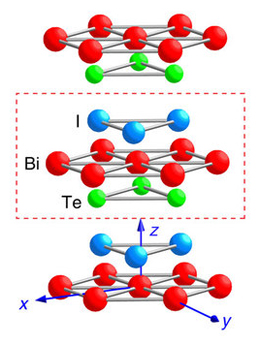Research Abstract
圧力下のBiTeIにおける非中心対称トポロジカル絶縁相の出現
Emergence of non-centrosymmetric topological insulating phase in BiTeI under pressure
2012年2月14日 Nature Communications 3 : 679 doi: 10.1038/ncomms1679

スピン軌道相互作用の影響は、さまざまな形で固体の電子構造にあらわれる。トポロジカル絶縁体は1つの例であり、スピン軌道相互作用によって、非自明なトポロジーを持つバルクのバンド構造が実現し、ギャップのない表面状態や端状態が観測される。もう1つの例がラシュバ効果であり、反転対称性を持たない系においてスピン軌道相互作用が電子スピン縮退を解く。これらの2つの効果、つまり電子状態の非自明なトポロジーとラシュバスピン分裂が、どのように相互作用しているかを知ることは特に重要である。今回我々は、最先端の第一原理計算によって、バルクの巨大ラシュバ半導体であるBiTeIが適切な圧力下でトポロジカル絶縁体に変化することを示した。この材料は、圧力によってその大きさを調整できる巨大ラシュバスピン分裂や特異な量子相転移だけでなく、試料の両側での著しく異なるディラック表面状態の形成など、いくつかの特徴的な性質を示すことが明らかにされた。
- 理化学研究所 基幹研究所 強相関量子科学研究グループ(CERG)
- 東京大学大学院 工学系研究科 物理工学専攻
- 理化学研究所 基幹研究所 交差相関物性科学研究グループ(CMRG)
The spin–orbit interaction affects the electronic structure of solids in various ways. Topological insulators are one example in which the spin–orbit interaction leads the bulk bands to have a non-trivial topology, observable as gapless surface or edge states. Another example is the Rashba effect, which lifts the electron-spin degeneracy as a consequence of the spin–orbit interaction under broken inversion symmetry. It is of particular importance to know how these two effects, that is, the non-trivial topology of electronic states and the Rashba spin splitting, interplay with each other. Here we show through sophisticated first-principles calculations that BiTeI, a giant bulk Rashba semiconductor, turns into a topological insulator under a reasonable pressure. This material is shown to exhibit several unique features, such as a highly pressure-tunable giant Rashba spin splitting, an unusual pressure-induced quantum phase transition, and more importantly, the formation of strikingly different Dirac surface states at opposite sides of the material.

